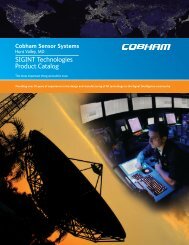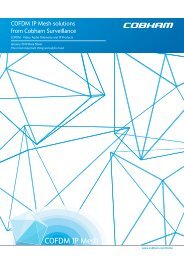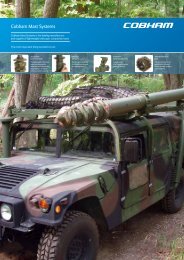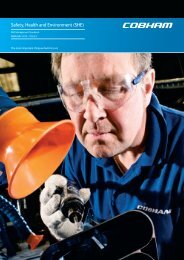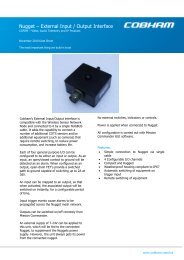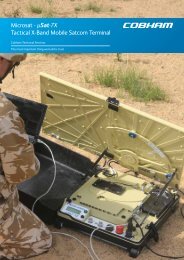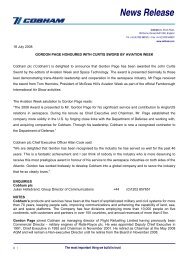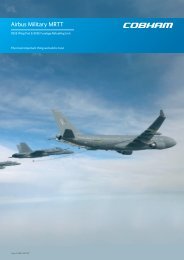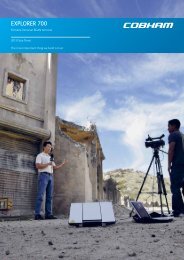Series 04 Ku-Band TVRO Antenna
Series 04 Ku-Band TVRO Antenna
Series 04 Ku-Band TVRO Antenna
Create successful ePaper yourself
Turn your PDF publications into a flip-book with our unique Google optimized e-Paper software.
Basic System Information<br />
<strong>Series</strong> <strong>04</strong> <strong>Ku</strong>-<strong>Band</strong> <strong>TVRO</strong> <strong>Antenna</strong><br />
3.2.4. <strong>Antenna</strong> polarization<br />
When you have a linear LNB installed the polarization needs to be periodically adjusted, Auto-<br />
Polarization will automatically accomplish this for you. You do not need to adjust the “polarization”<br />
of the antenna when you have a circular LNB installed, but rotation of the LNB does not have any<br />
detrimental effect, so Auto-Pol should remain ON.<br />
There is a ½ wave length phase card installed in the feed assembly. This causes the received<br />
satellite linear polarity to be mirrored/reversed in the feed. Therefore, to adjust polarization UP the<br />
LNB (as viewed from the back side of the reflector) must rotate CCW and to adjust polarity DOWN<br />
the LNB must rotate CW.<br />
Polarization adjustment to optimize Auto-Pol is required when initially setting up the system or<br />
after you have installed a different LNB (refer to the Maintenance Section of this manual).<br />
3.2.5. Interchangeable LNBs<br />
<strong>Series</strong> <strong>04</strong> antenna can easily be fitted with a variety of LNBs. The feed is capable of receiving linear<br />
or circular polarization signals, however, the LNB must match the type of polarization and the<br />
frequency band of the desired satellite. You must also have the correct receiver(s) installed below<br />
decks to decode each of the desired programming packages (as an example; To receive DirecTV in<br />
the US you must have DirecTV receivers installed, but DirecTV Latin America programming requires<br />
different receivers). Refer to the Maintenance section of this manual for the procedure used to<br />
change an LNB. The LNBs which may be used with this system are:<br />
US Circular LNB - This LNB is used to receive DirecTV, Dish Network or Bell ExpressVu<br />
programming.<br />
DLA Circular LNB - This LNB is used to receive DirecTV Latin America programming.<br />
European Quad Universal Linear LNB - This LNB is very popular for use in Europe. It<br />
can be used to receive low band horizontal & vertical AND/OR high band horizontal &<br />
vertical linear services at the same time. It can be used to receive one high band satellite or<br />
one low band satellite. Or it can receive both high & low band satellites at the same time, as<br />
long as they are at the same longitude position. It can NOT be used to receive two<br />
satellites at different longitude locations at the same time.<br />
3.2.6. Stabilization<br />
The <strong>Series</strong> <strong>04</strong> antennas are stabilized in three axes of motion. Stabilization is the process of decoupling<br />
the ships motion from the antenna. Simply put, this allows the antenna to remain pointed<br />
at the satellite while the boat turns, rolls or pitches under it. To accomplish this, the Pedestal<br />
Control Unit (PCU) on the antenna pedestal senses any motion of the antenna and immediately<br />
applies drive to the appropriate motor(s) to oppose the sensed motion. Azimuth (AZ), Elevation (EL)<br />
and Cross-Level (left-right tilt) are actively stabilized automatically by the PCU as part of its normal<br />
operation.<br />
3.2.7. Search Pattern<br />
Whenever the desired satellite signal is lost (such as when the antenna is blocked), the <strong>Antenna</strong><br />
Control Unit will automatically initiate a search to re-acquire the desired signal.<br />
The search is conducted with alternate azimuth and elevation movements. The size and direction<br />
of the movements are increased and reversed every other time resulting in an expanding square<br />
pattern.<br />
When the antenna finds the desired satellite signal, the ACU will automatically stop searching and<br />
begin Tracking the signal. Tracking optimizes the pointing of the antenna to get the highest signal<br />
level from the satellite.<br />
3.2.8. Tracking Receiver - Satellite Identification Receiver<br />
The Satellite Identification Receiver located in the <strong>Antenna</strong> Control Unit (ACU) is used to acquire,<br />
identify and track a specific satellite by a unique network ID code (NID). The receiver must be set<br />
up properly for the satellite you wish to find & track. These receiver settings should be saved to<br />
expedite finding, or re-acquiring, the desired satellite in the future.<br />
3-4


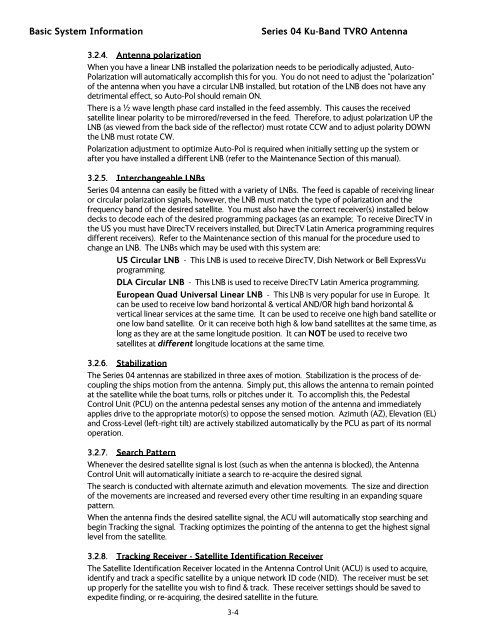


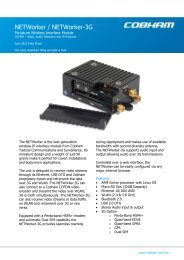
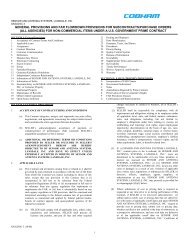
![NC1147 (pdf 1.47 mb) Nitrogen Concentrator [OBIGGS] - Cobham plc](https://img.yumpu.com/51124104/1/190x245/nc1147-pdf-147-mb-nitrogen-concentrator-obiggs-cobham-plc.jpg?quality=85)
